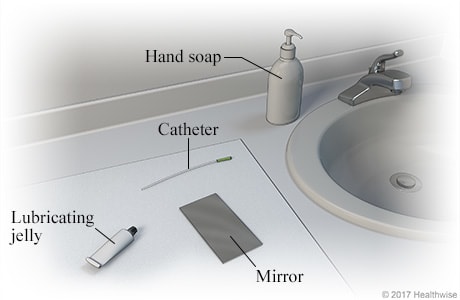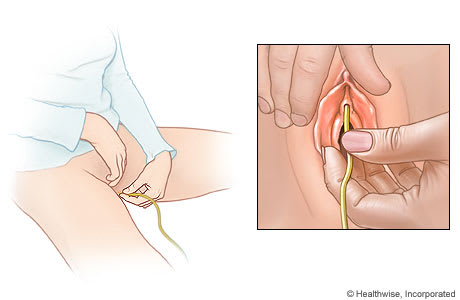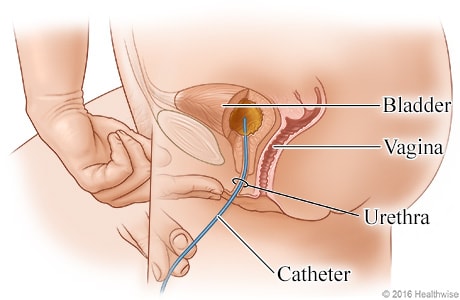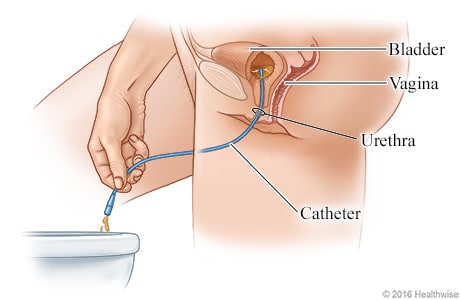Jump to
What is self-catheterization?
Self-catheterization is a way to regularly empty your bladder. You insert a catheter through the urethra into the bladder. The catheter is not permanent.
How to use a straight catheter at home (female)
When you need to empty your bladder, try to urinate first, if you can, before you use the catheter.
- Gather the supplies you need to insert the catheter.

You will need:
- The catheter.
- A mirror, if you want to use one.
- A container to hold the urine. (If you empty the urine right into the toilet, you won't need the container.)
- Lubricating jelly, such as K-Y Jelly, that dissolves in water. Don't use a petroleum jelly such as Vaseline.
You may want to use a clean washcloth or towel, plus a bag or plastic tub to hold the supplies.
Be sure to wash and dry your hands.
- Find and clean the area around the urethra.
 Choose a comfortable position with your legs spread. You may want to put one leg up on the toilet. Or you can lie on your back with your legs bent and spread in a "frog" position. Place the urine container (if you are using one) between your legs.Separate the lips of your vulva (labia). Clean the area well with soap and water.Spread the lubricating jelly on the tip of the catheter. Put the other end of the catheter over the toilet bowl or in the container to catch the urine.
Choose a comfortable position with your legs spread. You may want to put one leg up on the toilet. Or you can lie on your back with your legs bent and spread in a "frog" position. Place the urine container (if you are using one) between your legs.Separate the lips of your vulva (labia). Clean the area well with soap and water.Spread the lubricating jelly on the tip of the catheter. Put the other end of the catheter over the toilet bowl or in the container to catch the urine. - Insert the catheter.
 Gently insert the catheter into the urethra opening until urine begins to flow out. (You may want to use a mirror to see better.) Then insert it about 1 inch more.Let the urine drain into the container or the toilet.
Gently insert the catheter into the urethra opening until urine begins to flow out. (You may want to use a mirror to see better.) Then insert it about 1 inch more.Let the urine drain into the container or the toilet. - Drain the bladder and remove the catheter.
 Remove the catheter slowly. If you are using a disposable catheter, throw it away. If not, wash it with warm, soapy water. Dry it and put it into a clean container.Wash and dry your hands.
Remove the catheter slowly. If you are using a disposable catheter, throw it away. If not, wash it with warm, soapy water. Dry it and put it into a clean container.Wash and dry your hands.
Using a straight catheter for self-catheterization (female): When to call
Call your doctor now or seek immediate medical care if:
- You have symptoms of a urinary tract infection. These may include:
- Pain or burning when you urinate.
- A frequent need to urinate without being able to pass much urine.
- Pain in the flank, which is just below the rib cage and above the waist on either side of the back.
- Blood or pus in your urine.
- A fever.
- Your urine smells bad.
- You can't pass any urine.
Watch closely for changes in your health, and be sure to contact your doctor if you have any problems.
©2011-2025 Healthwise, Incorporated
The content above contains general health information provided by Healthwise, Incorporated, and reviewed by its medical experts. This content should not replace the advice of your healthcare provider. Not all treatments or services described are offered as services by us. For recommended treatments, please consult your healthcare provider.
